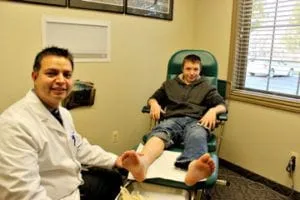
In the United States, medical and surgical care of the foot and ankle is mainly provided by two groups of physicians: podiatrists (Doctor of Podiatric Medicine or DPM) and orthopedists (MDs or DOs).
The first year of podiatric medical school is similar to training that M.D. and D.O. students receive, but with an emphasized scope on foot, ankle, and lower extremity. Being classified as a second entry degree, in order to be considered for admission an applicant must first complete a minimum of 90 semester hours at the university level or more commonly, complete a bachelor’s degree with emphasis on general/organic chemistry, biochemistry, biology, etc. In addition, potential students are required to take the Medical College Admission Test (MCAT). The DPM degree itself takes a minimum of four years to complete.
The four-year podiatric medical school is followed by a surgical based residency, which is hands-on post-doctoral training. There are two standard residencies: Podiatric Medicine & Surgery 24 and Podiatric Medicine & Surgery 36 (PM&S 24 or PM&S 36). These represent the two- or three-year residency training. By July 2013, all residency programs in podiatry will be required to transition to a minimum three-years of post-doctoral training.[25] Podiatric residents rotate through core areas of medicine and surgery. They work along side their MD and DO counterparts in such rotations as emergency medicine, internal medicine, infectious disease, behavioral medicine, physical medicine & rehabilitation, vascular surgery, general surgery, orthopedic surgery, plastic surgery, dermatology and of course podiatric surgery and medicine. Fellowship training is available after residency in such fields such as geriatrics, foot and ankle traumatology, infectious disease etc. In reality though, the residency training of most podiatry residencies today are already highly inclusive of these medical areas.
Podiatric Surgical Training
Upon completion of their residency, podiatrists can decide to become board certified by a number of specialty boards including the more common American Board of Podiatric Orthopedics and Primary Podiatric Medicine and/or the American Board of Podiatric Surgery. The ABPMS or The American Board of Podiatric Medical Specialties has been certifying podiatrists since 1998. ]Within the American Board of Podiatric Surgery, PM&S 24 graduates can sit for Board Certification in Foot Surgery and those that complete PM&S 36 can sit for Board Certification in Foot Surgery and Board Certification in Reconstructive Rearfoot & Ankle Surgery. Both boards in ABPS are examined as separate tracks. Though the ABPS and ABPOPPM are more common, other boards are equally challenging and confer board qualified/certified status.
